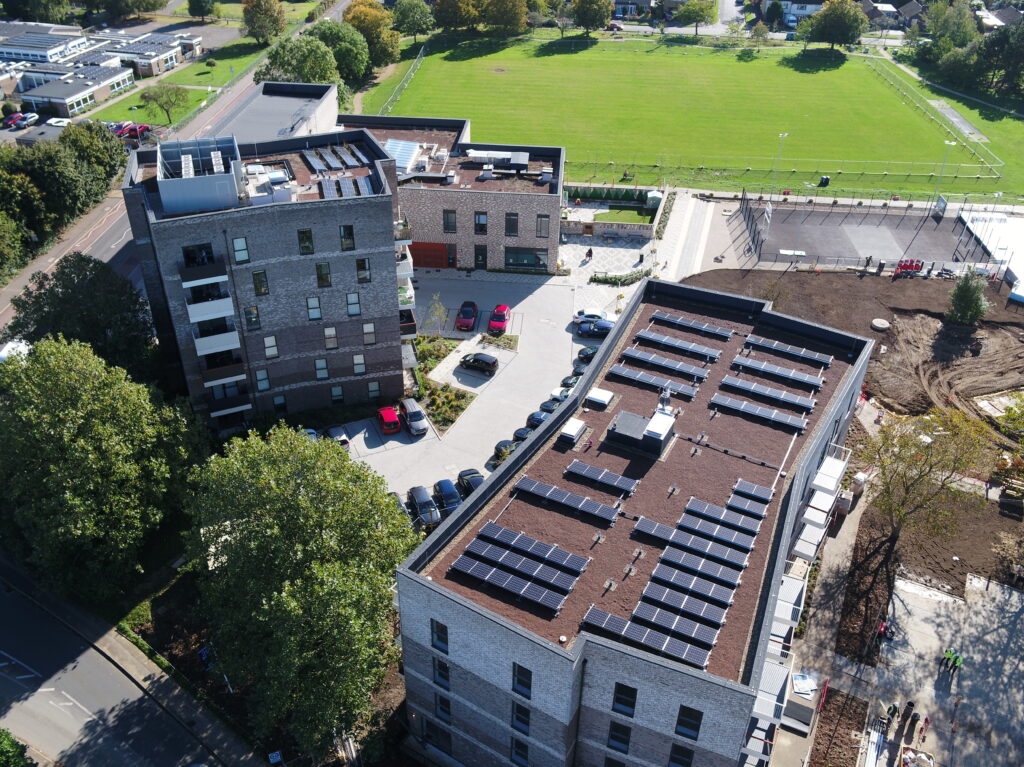
Project Overview
Buchan Street and The Meadows is a community-focussed project in Arbury, Cambridge, designed by Pollard Edward Thomas Architects and delivered by The Hill Group for Cambridge Investment Partnership.
Former community facilities have been consolidated into a highly sustainable community hub spread across two sites, offering essential local amenities, energy efficient housing, leisure and retail space, and extensive landscaped areas. More than 93% of the original open space has been retained by the development, which also sees the planting of 109 new trees.
Seventy-eight new one- and two-bedroomed council-rented flats have been created at The Meadows, with a further twenty-eight at Buchan Street. Impressive levels of sustainability have been achieved at the properties by way of thermally efficient insulation, gas-free heating, solar panels, mechanical ventilation, and heat recovery to filter air within the homes.
A new community centre at The Meadows site has been designed to BREAAM Excellent specifications, putting it in the top 10% of non-domestic buildings in the UK for energy efficiency.
Client Brief
The project required a single source waterproofing and green roof system, with The Hill Group and Pollard Thomas Edwards Architects preferring to deal directly with a supplier offering one sole point of contact for any technical enquiries arising.
Enviromental factors were key to specification. It was imperative that the chosen systems contribute to achieving the BREAAM Excellent standard on the community centre, whilst also offering unrivalled performance and maximising sustainability across the entire project.
The overall objective was to create future-proof homes and facilities, that will adapt to the ever-changing needs of the community.
Solution
In total, 3,000m2 of Hydrotech Waterproofing and Blackdown Green Roofs were installed across all of the new buildings at Buchan Street and The Meadows, including the new apartment blocks and community centre.
Hydrotech is a hot-melt monolithic membrane boasting 40% recycled content and zero product failures in over 50 years. It is appied in liquid form to achieve no seams, and installed with XPS insulation to further improve energy efficiency, in keeping with the client brief.
The system, which is BBA and ETA certified, achieves a fire classification rating of Broof (t4). It was supplied with 35-year warranty, ensuring complete peace of mind for the client, and continual performance and durability for the full service life of the roof.
Blackdown green roofing systems also aligned perfectly with the environmental considerations of the project. They assist with rainwater retention, improve air quality in the immediate vicinity, and encourage biodiversity by providing habitats for a variety of birds, insects and other wildlife.
Nurturing Relationships
Only by being involved with a project from the outset, can we earn the trust of our construction partners and ensure the most effective product specification.
Our technical team worked closely in collaboration with Pollard Thomas Edward Architects and The Hill group from the early design stages. We were able to overcome a number of detailing queries, specifically, low roof and door threshold junctions, AOV upstands, lift overuns and smoke shaft junctions.
Expert installation was carried out by Cambridge Flat Roofing, who have previous experience of Alumasc Roofing systems and a well-established relationship with our technical team.
Simon Redgrave is the Senior Site Manager for The Hill Group, he comments:
“The whole installation at Buchan Street and The Meadows was straightforward and ran extremely smoothly. There were no supply issues, and deliveries of materials to site were timely, which was critical for co-ordinating crane lifts. Cambridge Flat Roofing were well organised and clearly very familiar with the Alumasc products.
Alumasc’s technical team visited site at regular intervals to check progress and test the system for watertightness. Everyone was very easy to deal with, and having now seen the process through from the outset, I have every confidence that the Alumasc system will stand the test of time, providing the project with the long-term, sustainable, leak-free roofing solution it needs.”
Exceeding Expectations
The Hydrotech and Green Roof systems installed at Buchan Street and The Meadows, will contribute directly to the 60% carbon reduction forecast by the project, which significantly exceeds the Cambridge Local Plan target of 19%.
The inclusion of green roofing will also enhance the existing meadows and woodland areas, to further support the overall 60% improvement in biodiversity achieved by the development.